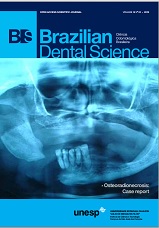Osteoradionecrosis: Case report
DOI:
https://doi.org/10.14295/bds.2015.v18i2.1009Resumo
Patients undergoing radiotherapy alone or as part of the treatment of head and neck cancer are likely to develop osteoradionecrosis (ORN). Dental extractions have been inferred as the main triggering factor of ORN, particularly in mandibular molars. The osteoradionecrosis has been reported in up to 20% of irradiated patients undergoing dental extraction and is recognized as the most severe complication of radiotherapy in the mandible, causing great discomfort and loss of quality of life of patients. The risk of ORN development is related to the dose, technique, and volume of irradiated tissue, and other predisposing factors such as: extraction at peri-radiotherapy period, site of extraction, pre-existing periodontal disease, general trauma, poor oral hygiene, nutritional deficiency, alcohol and smoking, and systemic diseases. The cellular injury and hypoxia caused by decreased blood supply reduce the recoverability of soft tissue and bone, predisposing them to necrosis and osteonecrosis, even spontaneous. Clinical management of osteoradionecrosis is complex and depending on the degree of involvement, it may require analgesics and antibiotics in addition to the adoption of surgical procedures, aiming to eliminate pain, control infection, and prevent or reduce the progression of the lesion. This paper aimed to report a case of osteoradionecrosis treated in the multidisciplinary clinic of the Onco Project - ICT/UNESP (São José dos Campos/SP, Brazil). A female patient aged 65 years with osteoradionecrosis and fistula after radiotherapy of squamous cell carcinoma in gingiva was submitted to tooth extraction, antibiotic therapy and local care with good response and flow interruption through the fistula. During the treatment, the carcinoma relapsed and the patient was referred for oncologic treatment.
Downloads
Downloads
Publicado
Como Citar
Edição
Seção
Licença
TRANSFERÊNCIA DE DIREITOS AUTORAIS E DECLARAÇÃO DE RESPONSABILIDADE
Toda a propriedade de direitos autorais do artigo "____________________________________________________________________" é transferido do autor(es) para a CIÊNCIA ODONTOLÓGICA BRASILEIRA, no caso do trabalho ser publicado. O artigo não foi publicado em outro lugar e não foi submetido simultaneamente para publicação em outra revista.
Vimos por meio deste, atestar que trabalho é original e não apresenta dados manipulados, fraude ou plágio. Fizemos contribuição científica significativa para o estudo e estamos cientes dos dados apresentados e de acordo com a versão final do artigo. Assumimos total responsabilidade pelos aspectos éticos do estudo.
Este texto deve ser impresso e assinado por todos os autores. A versão digitalizada deverá ser apresentada como arquivo suplementar durante o processo de submissão.




























